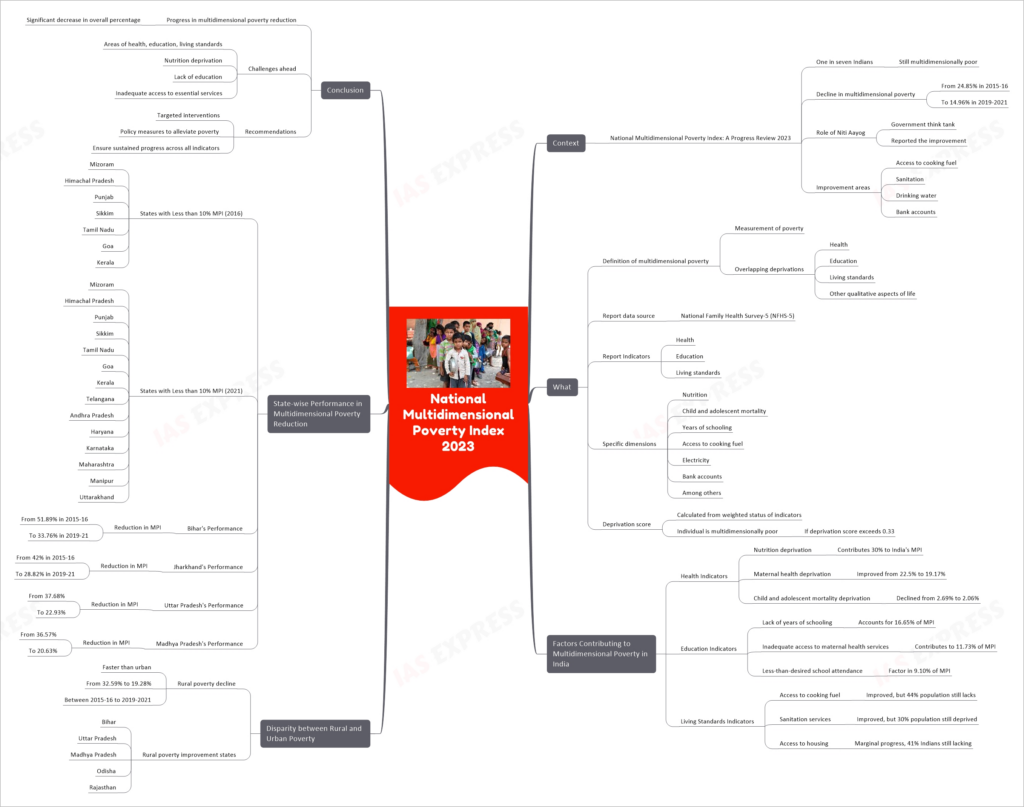National Multidimensional Poverty Index 2023: Highlights, Indicators, State-wise Rankings

From Current Affairs Notes for UPSC » Editorials & In-depths » This topic
IAS EXPRESS Vs UPSC Prelims 2024: 85+ questions reflected
India has experienced a decline in the number of individuals classified as “multidimensionally poor” from 24.85% in 2015-16 to 14.96% in 2019-2021, as reported by the government think tank Niti Aayog. This improvement can be attributed to advancements in indicators such as access to cooking fuel, sanitation, drinking water, and bank accounts. The report titled ‘National Multidimensional Poverty Index: A Progress Review 2023’ highlights that despite this progress, one in seven Indians still falls under the category of multidimensional poverty.
What is Multidimensional Poverty?
- Multidimensional poverty refers to the measurement of poverty that takes into account overlapping deprivations in health, education, living standards, and other qualitative aspects of life.
- Niti Aayog’s report utilizes the National Family Health Survey-5 (NFHS-5) as the primary data source to determine the Multidimensional Poverty Index (MPI).
- The report identifies three broad indicators: health, education, and living standards, each containing specific dimensions.
- These dimensions include nutrition, child and adolescent mortality, years of schooling, access to cooking fuel, electricity, and bank accounts, among others.
- A deprivation score is calculated based on the weighted status of these indicators, with an individual being considered multidimensionally poor if their deprivation score exceeds 0.33.
Factors Contributing to Multidimensional Poverty in India
- Health Indicators:
- Nutrition deprivation remains a significant factor, contributing close to 30% to India’s multidimensional poverty index.
- Maternal health deprivation improved moderately from 22.5% to 19.17%.
- Child and adolescent mortality deprivation declined from 2.69% to 2.06%.
- Education Indicators:
- Lack of years of schooling accounts for 16.65% of multidimensional poverty.
- Inadequate access to maternal health services contributes to 11.73% of the index.
- Less-than-desired school attendance is a factor in 9.10% of multidimensional poverty.
- Living Standards Indicators:
- Access to cooking fuel has significantly improved; however, approximately 44% of the population still lacks this access.
- Sanitation services have also seen improvements, but over 30% of the population remains deprived in this area.
- Marginal progress has been made in access to housing, with over 41% of Indians lacking adequate housing.
Disparity between Rural and Urban Poverty
While there is a major disparity between rural and urban poverty rates, rural areas have witnessed a faster decline in poverty. From 2015-16 to 2019-2021, rural poverty decreased from 32.59% to 19.28%, primarily due to improvements in states such as Bihar, Uttar Pradesh, Madhya Pradesh, Odisha, and Rajasthan.
State-wise Performance in Multidimensional Poverty Reduction
- States with Less than 10% Multidimensional Poverty (2016):
- Mizoram
- Himachal Pradesh
- Punjab
- Sikkim
- Tamil Nadu
- Goa
- Kerala
- States with Less than 10% Multidimensional Poverty (2021):
- Mizoram
- Himachal Pradesh
- Punjab
- Sikkim
- Tamil Nadu
- Goa
- Kerala
- Telangana
- Andhra Pradesh
- Haryana
- Karnataka
- Maharashtra
- Manipur
- Uttarakhand
- Bihar:
- Bihar has witnessed a significant reduction in multidimensional poverty, with the percentage decreasing from 51.89% in 2015-16 to 33.76% in 2019-21.
- Jharkhand:
- Jharkhand reduced the percentage of people living in multidimensional poverty from 42% in 2015-16 to 28.82% in 2019-21.
- Uttar Pradesh:
- Uttar Pradesh saw a decline in multidimensional poverty from 37.68% to 22.93%.
- Madhya Pradesh:
- Multidimensional poverty in Madhya Pradesh dropped from 36.57% to 20.63%.
Conclusion
India has made significant progress in reducing multidimensional poverty, with a decline in the overall percentage of individuals falling into this category. However, there are still considerable challenges to be addressed, particularly in the areas of health, education, and living standards. Nutrition deprivation, lack of education, and inadequate access to essential services continue to contribute significantly to multidimensional poverty. The report highlights the need for targeted interventions and policy measures to further alleviate poverty and ensure sustained progress across all indicators. By focusing on these critical areas, India can continue its journey toward eradicating multidimensional poverty and improving the well-being of its citizens.
If you like this post, please share your feedback in the comments section below so that we will upload more posts like this.


